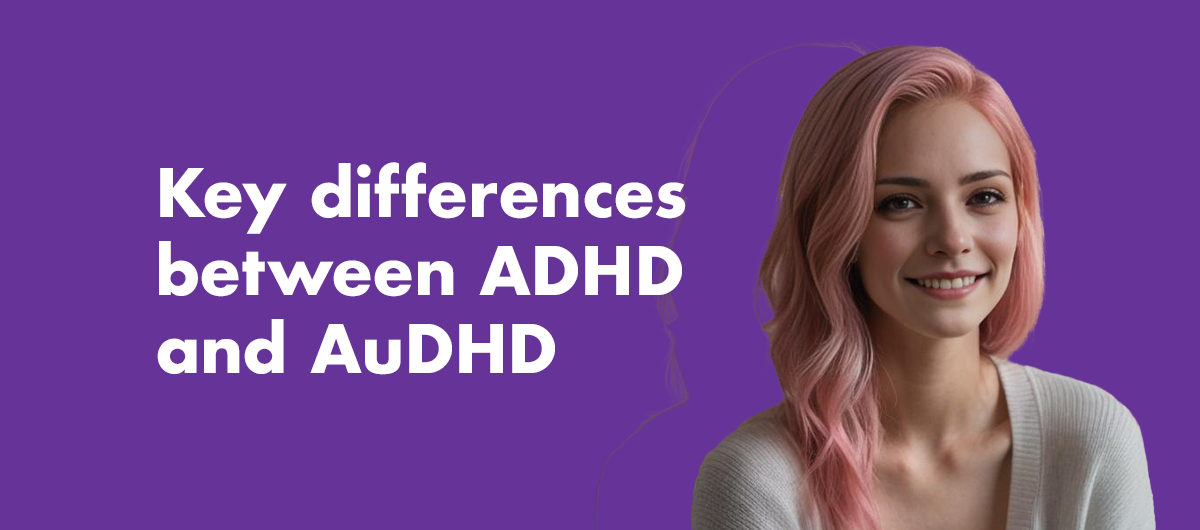ADHD (Attention-Deficit/Hyperactivity Disorder) and AuDHD (Autism with co-occurring ADHD) represent distinct neurodevelopmental profiles, though they share some overlapping features.
Understanding these differences is crucial for proper diagnosis, support and management strategies.
Core diagnostic features
ADHD is characterised by persistent patterns of inattention, hyperactivity, and impulsivity that interfere with functioning or development. These challenges typically manifest as difficulty sustaining attention, excessive motor activity, and acting without considering consequences.
AuDHD represents a dual diagnosis where both autism and ADHD co-occur. Autism involves differences in social communication and interaction, alongside restricted and repetitive behaviours, interests or activities. When combined with ADHD, the person experiences both the attention and regulation difficulties of ADHD alongside the autistic features.
Social communication and interaction
In ADHD, social difficulties typically stem from inattention, impulsivity or hyperactivity rather than fundamental differences in social understanding. People with ADHD may interrupt conversations, miss social cues due to inattention, or struggle with turn-taking, but generally understand social reciprocity.
With AuDHD, social challenges are more complex and fundamental. Beyond the ADHD-related social difficulties, there are qualitative differences in understanding social norms, reading non-verbal cues, and processing social information. This dual impact often creates more significant social challenges than either condition alone.
Sensory processing differences
People with ADHD may experience some sensory sensitivities or seeking behaviours, often related to their regulation difficulties. However, these are typically less pronounced than in autism.
AuDHD involves more significant and complex sensory processing differences. This might include heightened sensitivities (hypersensitivity) or reduced responses (hyposensitivity) to sensory input across multiple domains—sound, touch, taste, smell, and visual stimuli. These sensory differences can profoundly impact daily functioning and comfort.
Executive functioning challenges
ADHD primarily affects executive functions related to attention regulation, impulse control, and organisation. Working memory and time management are common areas of difficulty.
With AuDHD, executive functioning challenges can be more pervasive and complex. The autistic traits may add difficulties with cognitive flexibility, task transitioning, and handling unexpected changes. Executive function challenges often appear more resistant to standard ADHD interventions.
Restricted interests and repetitive behaviours
ADHD may involve intense interests, but these typically shift over time and are driven by novelty-seeking rather than a need for sameness or deep specialisation.
AuDHD includes the characteristic autistic pattern of restricted, repetitive behaviours and intense special interests. These interests tend to be more focused, enduring, and accompanied by exceptional depth of knowledge. Repetitive movements (stimming) and adherence to routines are also more pronounced.
Response to interventions
ADHD often responds well to stimulant medications, which can significantly improve attention, reduce hyperactivity, and enhance executive functioning. Behavioural strategies focused on organisation and attention are typically beneficial.
AuDHD requires more tailored and comprehensive approaches. Medication responses may be more variable, with the potential for different side effect profiles. Support strategies need to address both the ADHD symptoms and autistic features, requiring a more nuanced understanding of how these conditions interact.
Diagnostic considerations
Many experts now recognise that Australia lags behind in diagnosis rates compared to countries like the UK and US, particularly for adults seeking assessment. Women and girls are especially underdiagnosed in both conditions, often masking their difficulties through compensation strategies.
The increasing recognition of AuDHD as a distinct neurodevelopmental profile highlights the importance of a comprehensive assessment that considers how these conditions interact rather than viewing them in isolation. This recognition represents a significant shift in our understanding of neurodevelopmental diversity.
Understanding these differences not only aids in accurate diagnosis but also helps in developing appropriate support strategies that address the unique challenges and strengths associated with each neurotype.

Leave a Reply